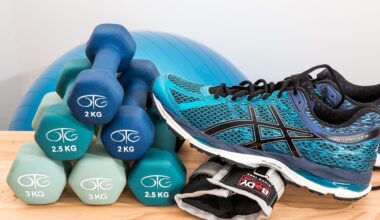Strength Training Warm-Up and Cool-Down Techniques for Older Adults
For older adults engaging in strength training, warming up is a critical component to minimize injury risk and enhance overall performance. A well-structured warm-up routine should focus on gradually raising the heart rate and increasing blood flow to muscles. Dynamic stretching exercises can be beneficial for warming the joints and muscles. Examples include arm circles, leg swings, and torso rotations. These movements help to lubricate joints, making them more mobile. Seniors should also consider low-impact aerobic activities such as walking or cycling for about five to ten minutes before initiating strength exercises. Additionally, listening to the body is essential; any signs of discomfort during warm-ups should result in adjusting or halting exercises. Staying hydrated and wearing comfortable clothing can further facilitate effective warm-up sessions. Gold standard guidelines suggest gradually increasing intensity during the routine. Seniors should ensure their warm-up lasts long enough to prepare the body for more intense exertion, thereby enhancing the effectiveness of their strength training sessions. Older adults need to engage in specific warm-up strategies tailored to individual fitness levels and capabilities.
The Importance of Cool-Down in Strength Training
Just as warming up is vital, cooling down is equally important after a strength training session for older adults. A cool-down period helps the body transition from an active state back to rest. Incorporating gentle stretching into the cool-down routine may improve flexibility and aid recovery. Seniors should focus on major muscle groups worked during the training, holding each stretch for at least 15 to 30 seconds. Examples of effective stretches include hamstring stretches, quadriceps stretches, and shoulder stretches. This practice helps reduce muscle tightness and soreness afterward. Moreover, cooling down allows the heart rate and breathing patterns to return to normal more gradually, which can prevent dizziness. Additionally, relaxation techniques, such as deep breathing exercises, can further enhance the benefits of cooling down. Incorporating a cool-down routine not only helps maintain physical health but also promotes psychological well-being. Taking a few moments after exercising to reflect on the training session may support mental clarity. Seniors should always prioritize their cool-down routine, as it solidifies the benefits gained from strength training and ensures safer long-term exercise habits.
Incorporating both warm-up and cool-down techniques into regular strength training routines provides several health benefits for older adults. Consistent practice may reduce the risk of injuries, improve overall flexibility, and potentially enhance emotional well-being. A structured warm-up engages both the mind and body, promoting better exercise adherence. Exploring different moving methodologies keeps the routine exciting while allowing individuals to discover what works best. Similarly, cool-down periods enrich the experience, encouraging older adults to foster a sense of accomplishment. These moments reflect on fitness journeys and recognize the progress they’ve made, which aids motivation. Simple routines can also be customized to fit diverse skill levels or limitations, ensuring better accessibility. Older adults must consult with healthcare professionals before embarking on new exercise regimes to ascertain suitability. The importance of partnering warm-up and cool-down exercises with strength training cannot be overstated. They fortify a holistic approach to health that integrates physical, mental, and emotional aspects. As a proactive measure, seeking out community-based exercise programs encourages social engagement, motivation, and safe exercise practices among peers in similar age brackets.
Recommendations for Effective Warm-Up Techniques
To optimize warm-up routines, older adults should start with a five to ten-minute low-intensity aerobic activity. This can include activities like brisk walking or stationary cycling, designed to gradually elevate the heart rate. Following the aerobic component, dynamic stretching should be incorporated to prepare the muscles and joints. Older adults can utilize exercises like leg swings, arms swings, and torso twists since these movements reflect exercises performed during strength training. When practicing these stretches, maintaining proper form ensures safety during warm-ups. Engaging in movements that mimic the upcoming strength exercises is advisable, as they provide a more effective transition. Additionally, exuding controlled breathing during warm-ups assists in maintaining focus and enhancing performance. Each movement should be executed with purpose and mindfulness to further improve efficacy. It is also crucial to incorporate warm-up activities that are enjoyable and stimulating to encourage regular engagement. Seeking guidance from certified trainers can assist in designing personalized warm-ups that enable greater physical activity optimization. Overall, establishing an empowering routine ultimately influences long-term fitness goals.
When considering cool-down routines, older adults should integrate gentle stretches immediately following strength training sessions. This practice helps mitigate muscle tightness and reduces the risk of injury from subsequent activities. Key stretches should target the major muscle groups used during the workout. It’s important to maintain each stretch for 15 to 30 seconds to promote effective elongation of muscle fibers. Incorporating additional relaxation techniques such as mindfulness or deep breathing can enhance the overall cooling-down experience. An effective cool-down combines movement quality with restorative practices, creating a comprehensive approach to recovery. Staying mindful during this period encourages seniors to recognize bodily feedback, thereby fostering better body awareness. This increased awareness aids individuals in optimizing their future workout regimens. Furthermore, encouraging older adults to hydrate during this restorative period also contributes positively to recovery. Hydration supports muscle function and general well-being, especially after strength training. Establishing a solid cool-down routine cultivates responsibility and care for one’s own body. Ultimately, this practice embodies a commitment to maintaining health and well-being among older populations, promoting greater longevity and quality of life.
Common Mistakes During Warm-Up and Cool-Down
While warm-up and cool-down routines are essential for older adults, common mistakes can lessen their effectiveness. One prevalent error is neglecting the warm-up entirely, which can lead to injuries. Failing to allocate adequate time for these components can negatively impact performance and recovery. Improper stretching techniques, such as bouncing while holding a stretch, should also be avoided, as they can strain muscles. Instead, seniors should focus on smooth, controlled stretches. Conversely, some older adults may overly rush their cool-down, limiting its restorative benefits. Skipping the cool-down altogether often leads to stiffness and discomfort. Furthermore, maintaining hydration throughout both warm-up and cool-down sessions is often overlooked, undermining the benefits. Recommendations include integrating hydration reminders into their routine. Additionally, seniors must avoid high-intensity movements during warm-ups, as they can increase injury risk. Including movements that closely resemble training exercise prepares the body more efficiently. Promoting proper awareness of personal capabilities is also vital in preventing overexertion. Establishing a well-rounded knowledge of effective strategies encourages informed choices and enhances the overall strength training experience.
Ultimately, incorporating both warm-up and cool-down techniques into exercise regimens is vital for older adults. Developing a tailored routine brings numerous health benefits that promote safe engagement with strength training activities. These practices not only minimize injury risk but also enhance flexibility and recovery time. Such routines foster emotional well-being, as they encourage mindful interaction with physical activity. Seeking guidance from fitness professionals can help older adults construct effective plans and tailor warm-up and cool-down sessions to personal needs. Setting realistic expectations can enhance confidence, facilitating progress within the individual’s fitness journey. Acknowledge the importance of gradual progression to ensure adaptation while decreasing injury risk. As older adults commit to regular strength training, realizing the significance of warm-ups and cool-downs transforms their experience into one of empowerment. Engaging in community exercise programs nurtures social connections that can further inspire motivation. Observing the holistic benefits of incorporating these techniques solidifies the role they play in overall health and wellness. Maintaining a consistent practice emphasizes personal strengths that encourage a meaningful and active lifestyle well into later years.
In conclusion, warm-ups and cool-downs are crucial aspects of strength training for older adults. They form the foundation for a safe and effective exercise regimen. Emphasizing both components leads to a gradual improvement in fitness levels, as well as an enhanced quality of life. As older adults continue their fitness journeys, they must prioritize these elements to achieve optimal results. Establishing effective routines solidifies their commitment to health maintenance. Inviting healthy habits cultivates positive changes that echo throughout their physical and psychological well-being. In addition to physical factors, encouragement and support from peers can significantly impact adherence to these practices. Providing older adults with access to appropriate resources is crucial for fostering healthier lifestyles. As they navigate their fitness experiences, continuing education about warm-up and cool-down techniques ensures empowerment. Ultimately, adopting comprehensive approaches not only facilitates more effective strength training but promotes lasting well-being. Regularly evaluating and modifying routines allows individuals to stay aligned with fitness goals and ensure ongoing safety. Therefore, the journey of strength training does not merely end with exercises; it encompasses overall health management too.


